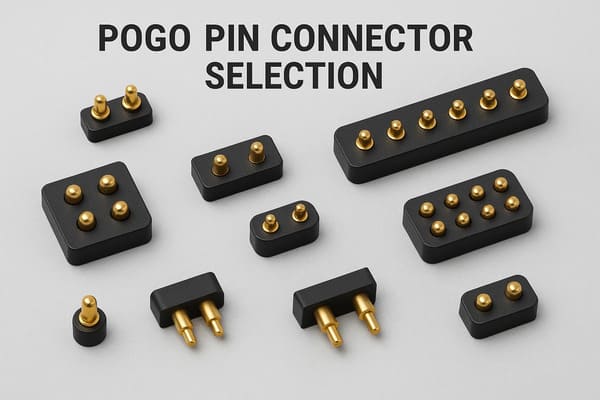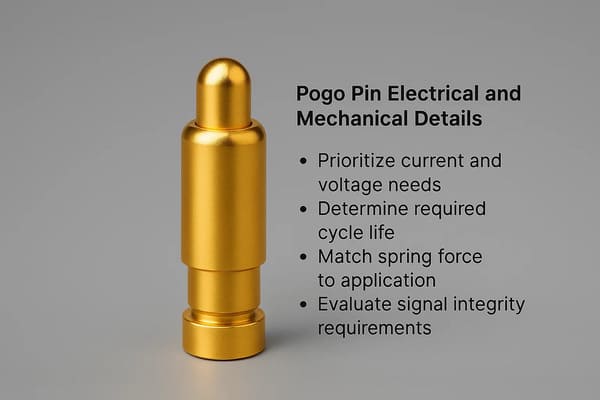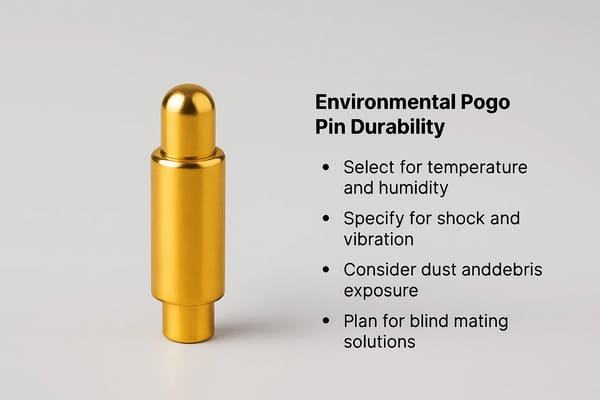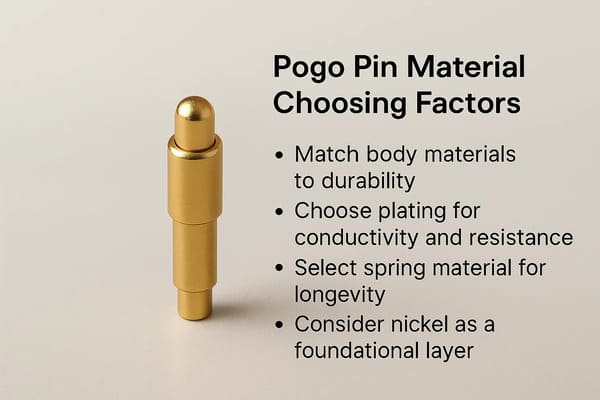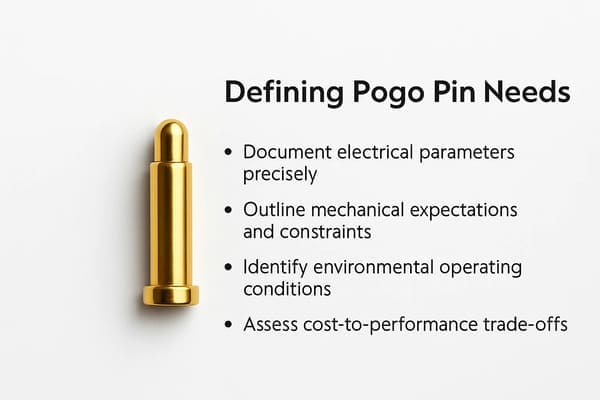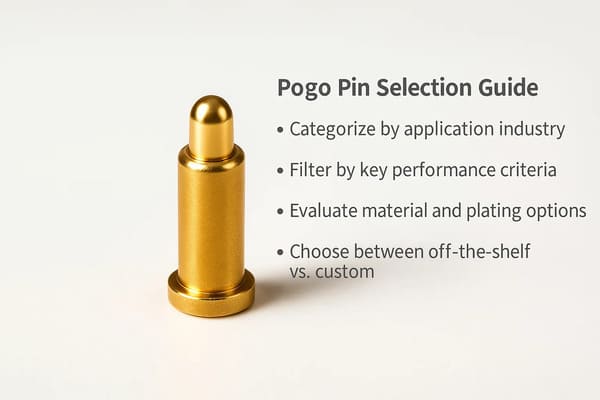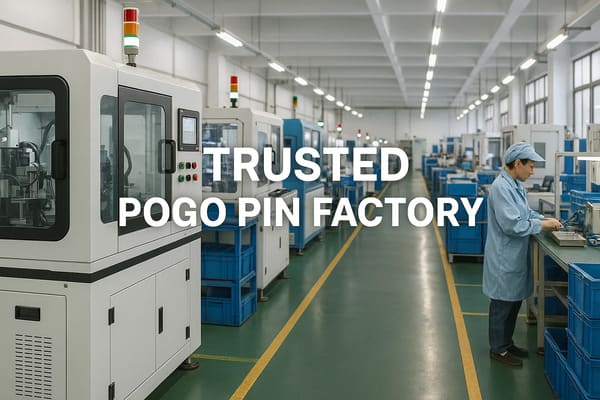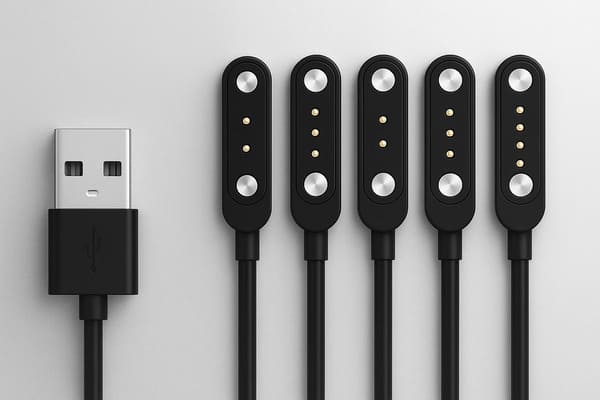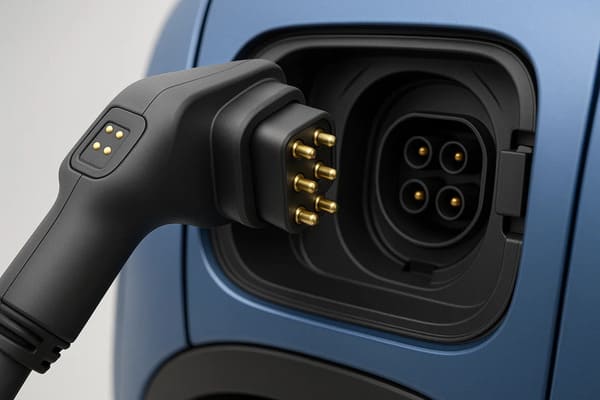Ever faced a product failure due to a faulty connector?
It’s a costly mistake many businesses encounter.
A poor choice in pogo pin connectors can disrupt reliability.
Let’s fix that with smart selection strategies.
Choosing the right pogo pin involves assessing contact resistance, spring force, and the plating materials used.
Consider the intended application’s environmental factors, such as vibration and temperature.
Proper selection ensures reliable electrical contact and long-term product performance.
This prevents costly failures and enhances device longevity.
Stick with us to explore actionable tips.
Dive into the pogo pin market insights.
We’ll show you how to match connectors to your project’s unique demands.
How Do You Match Pogo Pin Design to Performance Needs?
Struggling to pinpoint the right connector specs?
Many businesses overlook key performance factors.
A mismatch in pogo pin design can lead to signal loss or mechanical failure.
Matching pogo pin design to performance involves evaluating current rating, contact resistance, and spring force.
Consider the application’s shock and vibration requirements for mechanical stability.
Plating materials like gold optimize signal integrity and corrosion resistance, ensuring reliable long-term performance.
Let’s break this down further.
Stick around to uncover critical aspects of pogo pin selection.
These insights can shape smarter procurement decisions for your business.
Choosing a Pogo Pin by Electrical and Mechanical Specifications
Navigating specs can feel daunting without a clear plan.
Matching electrical and mechanical details to your application is vital for success.
- Prioritize current and voltage needs: Identify the power levels your product requires.
A pogo pin must handle the expected current, often ranging from 2 to 9 amps for high-demand uses.
Ensure voltage ratings align to prevent overheating or failure. - Determine required cycle life: Look at how often the connector will be mated and unmated.
High-quality pins can endure over 100,000 cycles.
Pick a design suited for frequent use if your application demands it. - Match spring force to application: Spring force, often around 60 grams at mid-stroke, affects contact stability.
Too much force can damage components, while too little risks a poor connection.
Balance is key for reliability. - Evaluate signal integrity requirements: For data transfer, low contact resistance is crucial.
Opt for pins with minimal signal loss, especially in high-frequency setups.
This ensures clear, uninterrupted transmission.
Getting these specs right prevents costly redesigns.
Let’s explore how the environment plays a role in your pogo pin choice next.
Choosing a Pogo Pin by Application Environment
Harsh conditions can ruin even the best connectors.
Temperature, humidity, and vibration often catch buyers off guard.
A durable spring loaded pin must withstand your specific environment.
- Select for temperature and humidity: Pins face extremes in industrial or outdoor settings.
High-temperature resistant options work up to 340°C with proper plating.
Waterproof designs with seals handle moisture effectively. - Specify for shock and vibration: In automotive or aerospace, connectors must endure constant movement.
Designs tested for 50g shock and 10g vibration ensure stability.
Look for robust builds to avoid disconnects. - Consider dust and debris exposure: Dusty environments can compromise contact points.
Sealed pogo pins or self-cleaning designs reduce contamination risks.
This extends the lifespan in challenging settings. - Plan for blind mating solutions: When alignment isn’t guaranteed, floating or magnetic pogo pins help.
They adjust to minor misalignments, ensuring contact without damage.
Ideal for complex assemblies.
Matching the environment to the connector boosts reliability.
Up next, let’s tackle how materials impact performance.
Choosing a Pogo Pin by Material and Plating
Materials define a connector’s longevity and conductivity.
Picking the wrong combination can lead to corrosion or wear.
A reliable pogo pin factory offers options to fit your needs.
- Match body materials to durability: Brass and beryllium copper are common for plungers and barrels.
Brass is cost-effective with good conductivity.
Beryllium copper shines in high-frequency, high-stress uses due to low resistance. - Choose plating for conductivity and resistance: Gold plating enhances conductivity and fights corrosion, perfect for demanding applications.
Nickel undercoats add hardness.
Tin suits budget-focused projects but wears faster. - Select spring material for longevity: Stainless steel springs balance elasticity and corrosion resistance.
Music wire offers high elasticity but a shorter lifespan.
Beryllium copper excels under constant stress. - Consider nickel as a foundational layer: Nickel boosts wear resistance and protects against harsh conditions.
Often paired with gold, it extends pin life.
It’s a smart base for many environments.
Material choices shape performance outcomes.
Let’s dive into a structured approach to finalize your selection.
What Is the Best Pogo Pin Selection Process for Your Business?
Finding the right connector feels overwhelming without a plan.
Many skip steps, risking mismatched components.
A structured approach with a trusted pogo pin supplier simplifies success.
The optimal pogo pin selection process starts by defining clear electrical and mechanical requirements.
Next, evaluate suitable connector types based on current capacity, cycle life, and environmental factors.
Finally, validate choices through prototyping and performance testing to ensure compatibility and reliability for your product.
Stay tuned for a detailed breakdown.
These steps will transform how you source connectors for lasting results.
Step 1: Defining Your Application’s Core Requirements
Clarity in needs sets the foundation for smart choices.
Without defined parameters, you risk costly errors in connector selection.
- Document electrical parameters precisely: Note voltage, current, and signal needs.
High-current applications may need pins rated for 9 amps or more.
This prevents overload and ensures smooth operation. - Outline mechanical expectations and constraints: Define size, shape, and mounting style.
Surface-mount pins save space in compact designs.
Ensure fit with your PCB or device layout. - Identify environmental operating conditions: Factor in temperature, humidity, and vibration exposure.
Pins for outdoor use need waterproof or shock-resistant features.
Match conditions to avoid early failure. - Assess cost-to-performance trade-offs: Balance quality with budget.
Premium materials like gold plating cost more but offer longevity.
Decide where to invest for maximum value.
With requirements set, you’re ready to pick the optimal type.
Let’s explore that next.
Step 2: Selecting the Optimal Pogo Pin Type
Narrowing down options can be tricky with so many variants.
A focused evaluation helps pinpoint the best spring loaded pin design.
- Categorize by application industry: Consumer electronics may need compact SMT pins.
Automotive demands high-vibration tolerance.
Match industry needs to narrow your search effectively. - Filter by key performance criteria: Look at cycle life, spring force, and current capacity.
Pins for testing might need over 100,000 cycles.
Pick based on core specs for reliability. - Evaluate material and plating options: Gold-plated pins suit high-reliability needs.
Brass works for budget builds.
Choose based on durability and environmental demands. - Choose between off-the-shelf vs. custom: Standard pins fit common uses and save time.
Custom designs from a pogo pin manufacturer address unique challenges.
Weigh speed against specificity.
You’ve got the type, but validation is key.
Let’s see how to partner for success.
Step 3: Partnering with the Right Supplier and Validating Your Choice
A great connector is only as good as its source.
Partnering with the wrong provider risks quality and delays.
A top pogo pin wholesaler ensures confidence.
- Assess manufacturer’s R&D capabilities: Strong research teams offer innovative solutions.
They can tailor designs for OEM or ODM projects.
This supports unique product goals. - Inquire about quality control processes: Rigorous testing standards prevent defects.
Ask about certifications like ISO9001.
Consistent quality saves you from field failures. - Request samples for thorough testing: Test pins in real conditions before bulk orders.
Check for alignment, contact, and durability.
This step avoids costly mismatches. - Compare total cost of ownership: Look beyond price to delivery times and support.
Fast sample turnaround, like 15 days, matters.
Factor in long-term reliability costs.
Partnering right seals the deal.
These steps ensure your connector performs as expected.
Conclusion
Selecting the right pogo pin connector shapes your product’s success.
This guide equips you with strategies to match design, environment, and specs. Make informed choices to enhance reliability.
For tailored solutions, explore more at Magnetic Pogo or reach out via Contact Us.
We’re here to support your B2B needs with expert insights.

